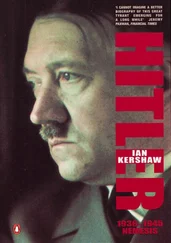32. BA/MA, N265/112, NL Heinrici, fos. 23–4. Speer, p. 471, dates the meeting to the 15th, not 14 April (as Heinrici has it), and mentions the discussion only of sparing the destruction of Berlin’s installations, not the issue of killing Hitler (which he alludes to, however, elsewhere in his memoirs). In later drafts of parts of his memoirs dating from 1966 or thereabouts, Heinrici again mentions the discussion with Speer about killing Hitler and his rejection of political murder because of his Christian convictions. He adds two points which were not mentioned in his earlier version. An assassination attempt would have been pointless, because of Hitler’s security, greatly tightened since July 1944. And, should such an attempt have nevertheless succeeded, the result would have been revolution 100 kilometres behind the front lines against the Russians. The ensuing chaos would have removed from the leadership all possibility of successful negotiations over an armistice. Whether such notions were in his mind in April 1945 or not is unclear. He drew the conclusion, in the later memoirs, that he had no alternative but to carry out his commission to hold the Oder line to the best of his ability.—BA/MA, N265/26, fos. 22–3 ( c . 1966). On Speer’s claims to have considered assassinating Hitler, see Matthias Schmidt, Albert Speer: Das Ende eines Mythos , Berne and Munich, 1982, pp. 147–51.
33. BA/MA, N245/3, NL Reinhardt, Kalenderblätter 1945, fo. 87, entries for 5.4.45, 13.4.45.
34. A telex from the Army Personnel Office on 13 April assigned small numbers of officers to the ‘Führer-Reserve’ of several Army Groups but pointed out that they now had to manage their own manpower resources and could not reckon with further allocations in the foreseeable future.—IWM, EDS, F.3, M.I. 14/163, FS to OB Nordwest, etc., 13.4.45. Seven new divisions were somehow thrown together in early April and given light armaments. But they were made up of seventeen-year-olds. They were meant for the defence of Thuringia, but would not be ready for service for a fortnight.— TBJG , II/15, p. 685 (8.4.45). By that time, Thuringia was lost.
35. e.g. StAA, Kreisleitung Günzburg 1/42, Gaustabsamt Gau Schwaben to named Kreisleitungen, 11.4.45.
36. BAB, NS6/756, fos. 2–6, Verstärkung der kämpfenden Truppe, 28.2.45.
37. BAB, NS6/135, fo. 160, Vorlage (for Bormann), re Panzernahbekämpfungstrupp der Hitler-Jugend, 3.3.45.
38. Information from Dr Hermann Graml, Institut für Zeitgeschichte, Munich, on his own experience in the Reich Labour Service in the last days of April 1945. Heavy pressure was put on boys to join. It could be resisted if sufficient determination were shown, for example by emphasizing strong allegiance to the Catholic Church, or, as in Dr Graml’s case, by producing call-up papers for the Wehrmacht. A contemporary in Württemberg claimed much later to recall that her then seventeen-year-old brother received a letter in February 1945 telling him that he had volunteered for the Waffen-SS, which had not been the case. He hurriedly volunteered for the Reich Labour Service to avoid it.— Zeitzeugen berichten… Schwäbisch Gmünd—Erinnerungen an die Zeit von 1930 bis 1945 , ed. Stadtarchiv Schwäbisch Gmünd, Schwäbisch Gmünd, 1989, p. 312.
39. See the testimony assembled in Nicholas Stargardt, Witnesses of War: Children’s Lives under the Nazis , London, 2005, pp. 268–9, 294–7, 303, 307.
40. Günter C. Behrmann, ‘ “Jugend, die meinen Namen trägt”: Die letzten Kriegseinsätze der Hitlerjugend’, in Kriegsende in Deutschland , Hamburg, 2005, p. 175.
41. StAA, Kreisleitung Günzburg 1/43, Strassen- und Flußbauamt, Neu-Ulm, 13.4.45; Gauleitung Schwaben, 1/28, fos. 328841–2, 328845, Heeresgruppe G to Gauleitung Schwaben, 13.4.45, Bormann to all Gauleiter, 13.4.45, passing on Keitel’s directive of 10.4.45; fos. 328807–8, Bormann’s order to ten named Gauleiter in central and southern Germany, 13.4.45; Gauleitung Schwaben, 1/29, fo. 328843, Aktnotiz für den Gauleiter: Versorgungslage der Wehrmacht und ziviler Behörden, 16.4.45; fo. 328835, note for Gauleiter Wahl from the Kreisleiter of Neu-Ulm, who, since the enemy was approaching, saw the need to call on the Volkssturm and the people’s levy to undertake entrenchment work and increase the number of barriers, 20.4.45.
42. BAB, R3/1622, fo. 102, Speer directive, transmitting Hitler’s order, 24.4.45; printed in ‘Führer-Erlasse’ 1939–1945 , ed. Martin Moll, Stuttgart, 1997, p. 497.
43. BAB, R3/1618, fo. 22, re Führer-Vorführung, 12.4.45.
44. BfZ, Sammlung Sterz, Uffz. Werner F., 1.4.45. Most soldiers’ letters, and those they received, were unpolitical in content and dealt in the main with inconsequential family or private matters. A report from one censors’ office for March stated on the basis of intercepted and controlled mail that 91.8 per cent of letters checked over the month were ‘colourless’, 4.7 per cent positively disposed towards the regime and 3.5 per cent negative (the last figure certainly underplaying true sentiments, given the dangers of expressing criticism). A separate control, under slightly different criteria, for the last eight days of March gave results of 77.08 per cent ‘colourless’, 8.82 per cent ‘positive’, 6.64 per cent ‘negative’ and 7.46 per cent ‘neutral’. The report included 113 varied extracts from the letters.—BA/MA, RH20/19/245, fos. 31–43, Feldpostprüfstelle bei AOK.19, Monatsbericht für März 1945, 3.4.45. For the organization of post to and from the front, see Richard Lakowski and Hans-Joachim Büll, Lebenszeichen 1945: Feldpost aus den letzten Kriegstagen , Leipzig, 2002, pp. 18–29.
45. BfZ, Sammlung Sterz, Tagebuch Uffz. Heinrich V., 10.4.45.
46. BfZ, Sammlung Sterz, Tagebuch Uffz. Heinrich V., 12.4.45.
47. Fritz, pp. 90–91.
48. LHC, Dempsey Papers, no. 319, pt. II, pp. 8–9 (18.4.45). The fate of the officer is not known.
49. TBJG , II/15, pp. 658 (1.4.45), 684, 687 (8.4.45), 692 (9.4.45); DRZW , 10/1 (Boog), pp. 830–83; Christian Hartmann and Johannes Hürter, Die letzten 100 Tage des Zweiten Weltkriegs , Munich, 2005, entry for Day 33, 7 April 1945. Hartmann and Hürter give the figure of 23 bombers destroyed. This seems close to the actual American figure of 17 bombers and 5 fighters destroyed in the air-battle, though most of these losses were apparently not directly caused by ramming. Some months earlier, a young man, a journalism student whose brother had fallen on the eastern front, and evidently a keen Nazi, expressed his disappointment to the SS newspaper, Das Schwarze Korps , at being rejected for suicidal service as a one-man torpedo because there had been too many applicants. Love of Germany, he said, was his motive.—BAB, NS19/2936, handwritten letter, no date (end of 1944 or beginning of 1945).
50. Fritz, pp. 72, 78–9, 88–9, 92.
51. Andreas Kunz, Wehrmacht und Niederlage: Die bewaffnete Macht in der Endphase der nationalsozialistischen Herrschaft 1944 bis 1945 , Munich, 2007, p. 254.
52. BA/MA, MSg2/2697, diary of Lieutenant Julius Dufner, fos. 154–61, entries for 13–20.4.45. Goebbels referred earlier in the month to the demoralization of the troops in Gau Weser-Ems, similar, he said, to reports that had until then come in from western parts of the Reich, as soldiers went about in loose groups, some throwing away their weapons, and engaging in looting.— TBJG , II/15, p. 673 (4.4.45).
53. TBJG , II/15, pp. 654–5, 659–60 (1.4.45). According to the diary notes of Goebbels’ aide, Rudolf Semmler, reports were emerging in early April from every town or village where American or British troops were approaching ‘that large numbers of the population are showing white flags and sheets’.—Rudolf Semmler, Goebbels—the Man Next to Hitler , London, 1947, p. 190 (5.4.45). See the diary entries reproduced in Gerhard Hirschfeld and Irina Renz, ‘Vormittags die ersten Amerikaner’: Stimmen und Bilder vom Kriegsende 1945 , Stuttgart, 2005, pp. 119, 125, 133, for examples of joy or relief at the arrival of American troops.
Читать дальше












